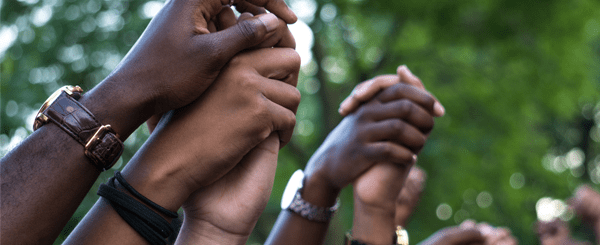Quantifying the Perils of Being Young and Black

A researcher at Rutgers University–Newark’s School of Criminal Justice put numbers to a national tragedy, finding that one in every 1,000 black men can expect to die at the hands of police. The findings are helping people make sense of senseless acts of violence.
America is raw after watching Minneapolis police officer Derek Chauvin suffocate George Floyd to death under his knee. And for good reason. Seeing a defenseless 46-year-old black man lying on the ground in handcuffs, gasping for air and pleading for his life as Chauvin kneeled on his neck for eight minutes and 46 seconds is deeply disturbing. Depicting a senseless act of violence, the footage is a testament to the long line of unarmed black Americans—among them Breonna Taylor, Eric Garner, Michael Brown, Laquan McDonald—who’ve been killed in acts of police brutality.
In the days since Floyd’s death, in demonstrations around the country, police in riot gear have roughed up unarmed protesters, dragged people out of their cars, and shot them with rubber bullets. Yet the protesters keep coming back. Even though Chauvin has been charged with second-degree murder, the demonstrations have raged on night after night. Hundreds of thousands have taken to the streets to hold the spotlight on this injustice as a way to force local governments and law enforcement to reckon with the oversized role that police violence plays in the lives of black Americans.
“For years, many black scholars and activists have been talking about how ubiquitous police violence is in their lives,” says Frank Edwards, assistant professor at the School of Criminal Justice. “I’m glad our work has helped put a number to it.” Along with researchers at the University of Michigan and Washington University in St. Louis, Edwards co-wrote a study published last summer that analyzed the risk of being killed by police use of force, according to age, race, and sex. The study showed that black men are 2.5 times more likely to be killed by law enforcement than are white men and that 1 in every 1,000 black men can expect to die at the hands of police over their lifetime.
Edwards says he’s seeing many people turn to their study in recent days to understand the scale of the problems behind the disproportionate use of force against African Americans. “For some segments of the media, and for some segments of the public, there was a desire to see definitive numbers on inequalities and risks for police killings, given how often these stories of the police killing black men and women come up in the news,” Edwards says. “Despite how much I wish they didn’t.”
Statistics like the ones cited in his study, along with heartbreaking anecdotal evidence, show a system that’s broken despite years of demonstrations and advocacy. And much ballyhooed reforms such as the adoption of body cameras have done little to change the police violence numbers. “We don’t want to have this research detract from the humanity of the stories we’re seeing play out, but for our part, we thought that police violence deserved to be treated like other forms of violence in terms of thinking of it as a population health problem,” Edwards says.
Edwards started working on the project in 2017, after Philando Castile was shot and killed by police outside of Minneapolis when he was stopped for a minor traffic violation. “In the process of looking into fatal police encounters, I realized that we really didn’t have good baseline estimates on how often police were killing civilians in the United States,” Edwards says. “So my colleagues Hedwig Lee and Michael Esposito and I thought we could be helpful by putting some definitive numbers together on racial inequality in American policing.”
For a long time, getting reliable data on deaths connected to police violence wasn’t easy because police departments aren’t required to report them to the federal government, with only some doing so voluntarily. “Even when it comes to basic crime rate numbers, we’re often missing data from 20 to 40 percent of police departments. And when it comes to use of force, when it comes to deaths, and when it comes to police killings, there are pretty clear disincentives for the police to provide those numbers to anybody.”
Over the past six years, after Michael Brown’s death and the uprisings in Ferguson, Missouri, news organizations such as The Washington Post have compiled comprehensive statistics on police-involved killings. “The only reliable data we’ve got right now on police-involved killings is because journalists and activists have taken it upon themselves to collect that data and make it available,” Edwards says. The data he and his colleagues used in their study was collected by Fatal Encounters, a group that aggregates news reports to document police killings and identify the victims’ demographic details. They also pulled data from the National Vital Statistics System, which compiles even more information from death certificates.
When the researchers set out to study the information, Edwards says, they expected to see inequalities when it comes to race, but not to the scale that they found. “Having a lifetime risk estimate of one in a thousand in which black men can expect to be killed by police—I mean, that’s pretty staggering,” he says. “We didn’t expect that police killings would be the sixth leading cause of death for black men between 25 and 29 years old.”
Edwards says that while the numbers have a powerful impact, they don’t offer a prescription for social change. “We wanted to draw attention to the problem and to alternatives that treat police violence as a public health concern, as a way to reduce the use of armed officers that engage with the public,” he says. He adds that taking a critical approach to thinking about law enforcement and issues of justice is a hallmark of how the School of Criminal Justice undertakes its work. And while he admits that there’s value in describing the scale of racial injustice, there’s a lot of work that needs to be done to fix it. “That’s where the conversation turns and there are definitely people that are better equipped than I am to talk about that,” he says.
Still, he’s heartened by the national push for police reforms, despite seeing pretty stark displays of violence across the country. “The way people are talking about policing, and the ways people are talking about police violence, I think it’s fundamentally different than where it was six years ago,” Edwards says. Understanding just how violent American law enforcement is, he adds, can also lead to addressing the long-term damage that radiates far beyond the original victims.
